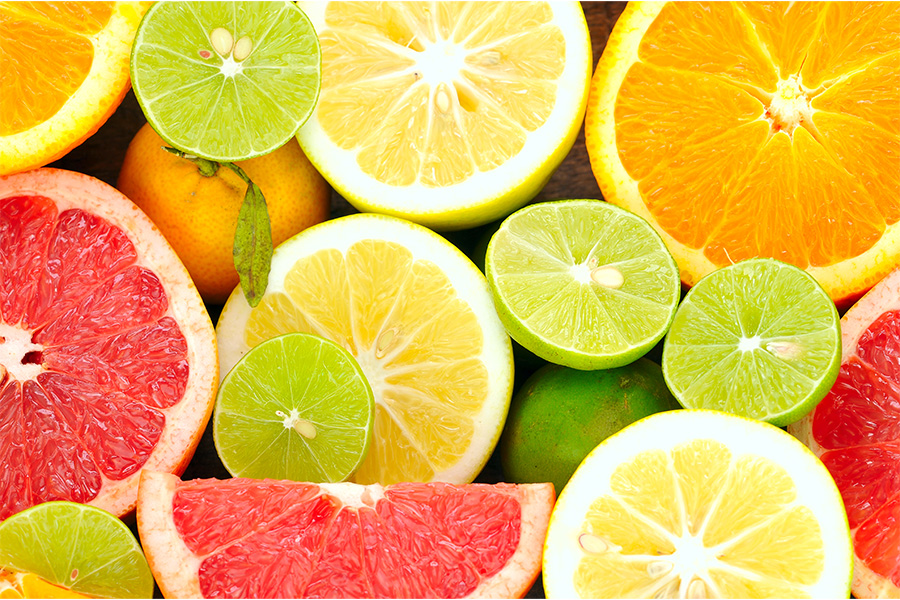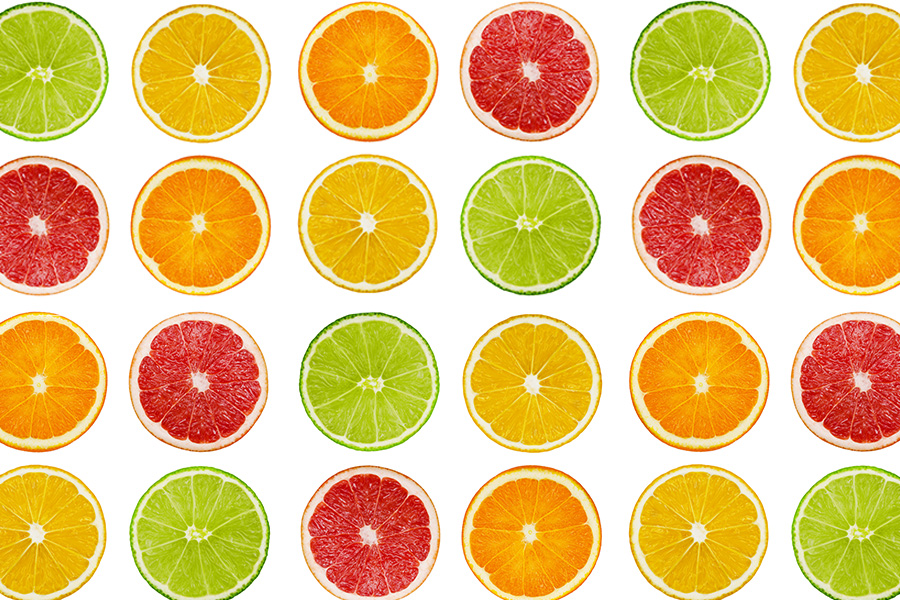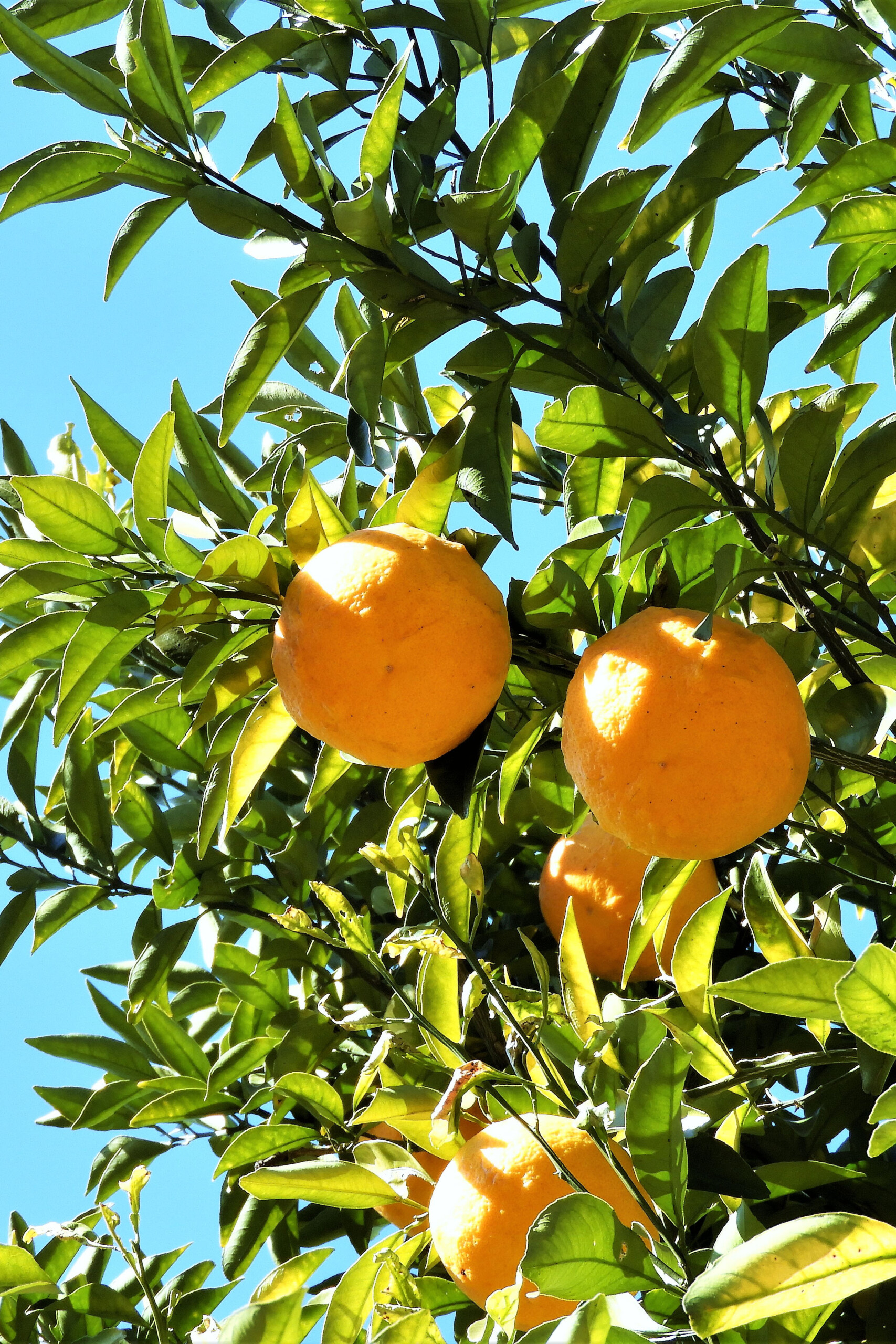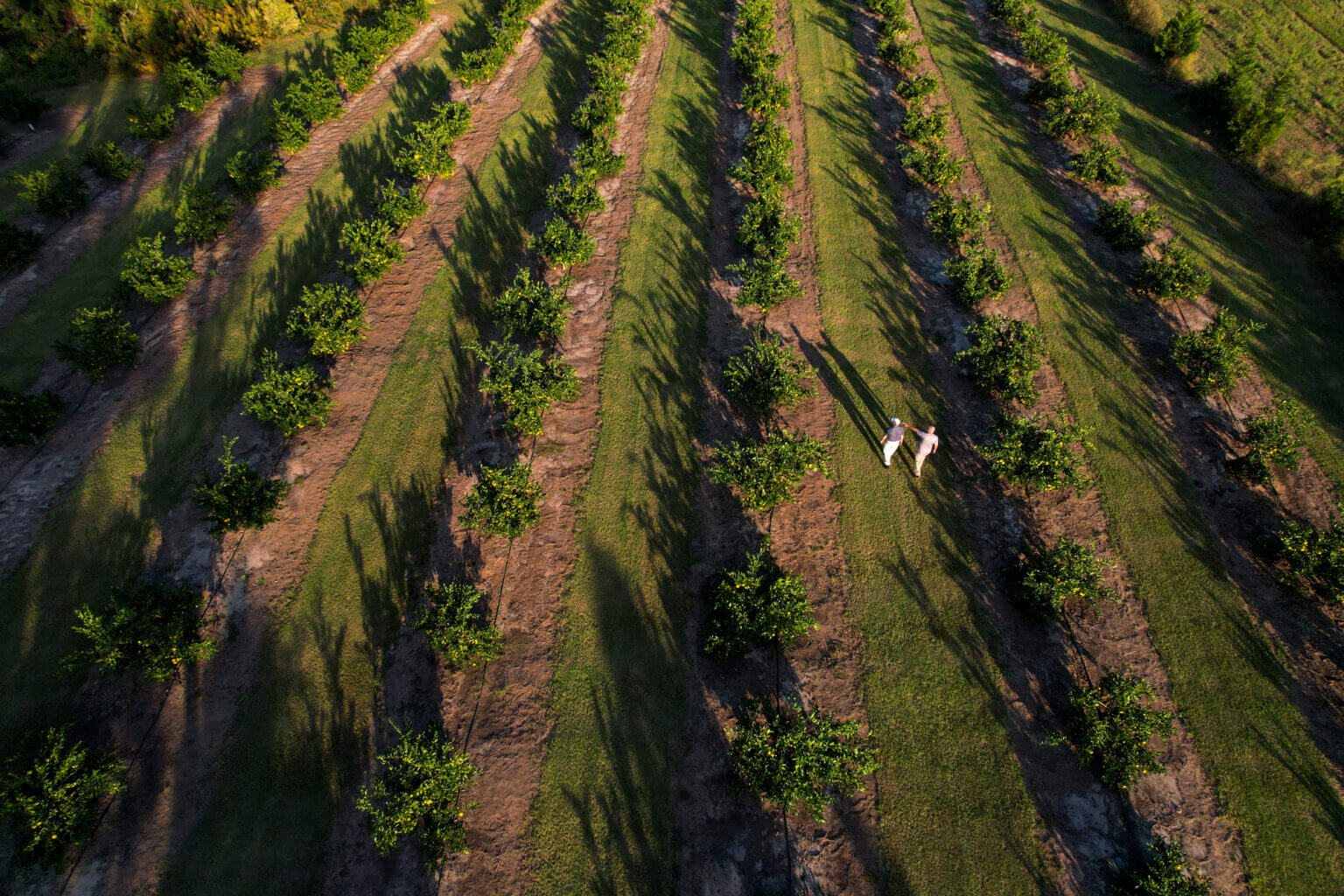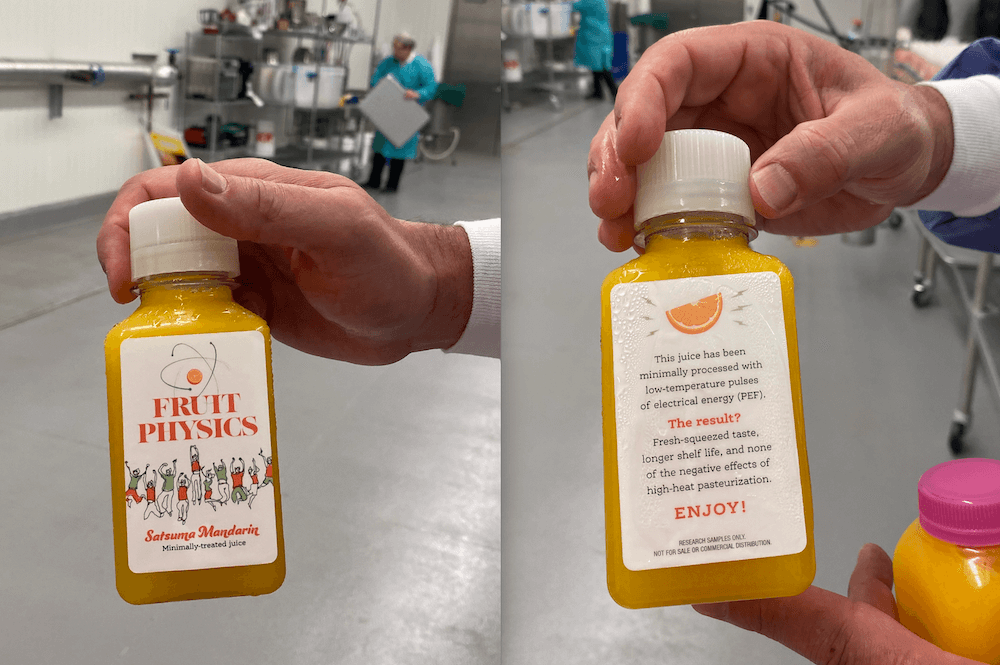Introduction
Satsuma mandarins are cold-hardy citrus trees that produce seedless, easy-to-peel fruits. They are distinguishable from other mandarin relatives by their loose peel. The most commonly planted variety is ‘Owari’, which is harvestable late October through mid-November. ‘Owari’ and other satsuma cultivars have issues with color development—often the fruit still have a green color externally while internally they have already reached marketable quality. This has been especially true over the last decade, as our summer temperatures often persist until mid-October. Cool fall temperatures help fruit turn orange.
While ‘Owari’ is the most popular variety grown in Georgia, home growers have an increasing interest in early-maturing citrus. There are satsuma varieties that are harvest-ready from late September to mid-October and develop orange color sooner (Figure 1) than ‘Owari’.
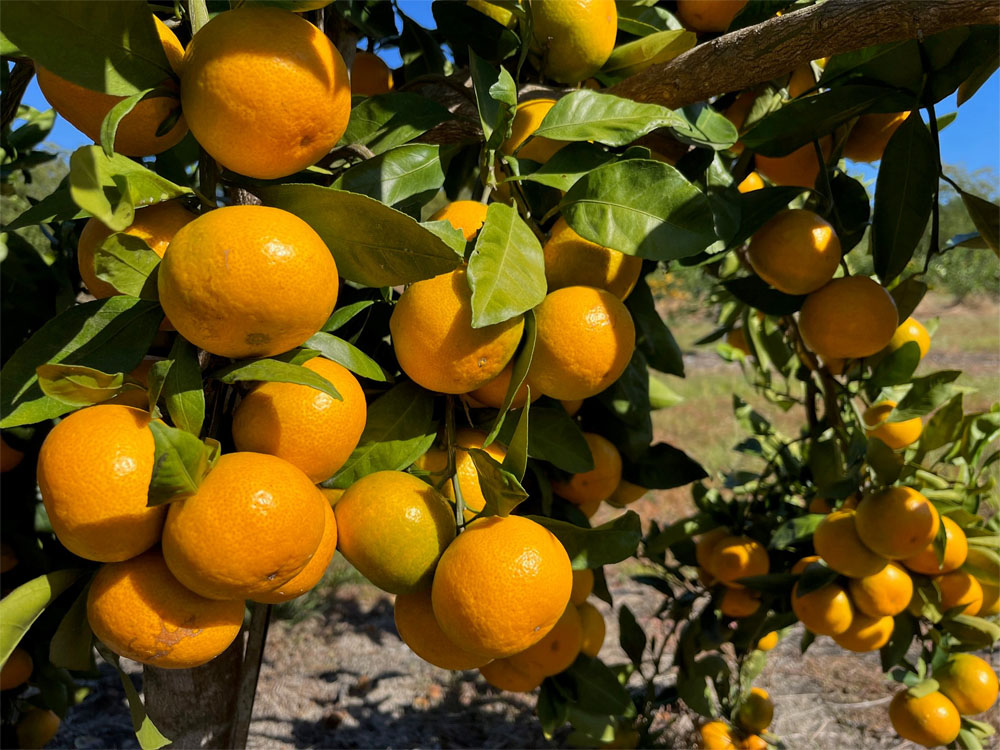
Satsuma Varieties
The citrus collection website at the University of California, Riverside, lists 49 different satsuma varieties with various descriptions (https://citrusvariety.ucr.edu/citrus-varieties/category-or-type/mandarins/satsumas). Retail stores or commercial citrus nurseries normally sell only a few satsuma varieties, so all 49 of the UC Riverside varieties are not readily available.
This publication evaluates 12 early-maturing satsuma varieties—and compares them to ‘Owari’—to determine which ones may be best suited for Georgia: ‘Iwasaki’, ‘LA Early’, ‘Early St. Ann’, ‘Brown Select’, ‘Miyamoto’, ‘Okistu Wase’, ‘Miho Wase’, ‘Miho’, ‘China S-9’, ‘Ueno’, ‘Xie Shan’, and ‘Miyagawa’. Many of these varieties originated from budwood obtained from the UC Riverside collection. The varieties tested were grafted onto either Poncirus trifoliata, ‘Rubidoux’, or trifoliate hybrid rootstocks.
The ages of the trees varied, but all trees had been in the ground for a minimum of 3 years prior to evaluation, with most trees ranging from 5 to 8 years old. The management practices of the trees differed because they were located at multiple sites.
Fruit Collection for Testing
Fruits were collected from trees of each variety from as many sites as possible, which ranged from one to five locations. Fruit from ‘Iwasaki’ and ‘LA Early’ were only tested from one site because of limited availability. Five fruits from each variety and site were juiced and tested at the end of September and 2 weeks later in mid-October. Testing was done in 2022 and 2023, and the same sites were tested both years. Photographs were taken of the sampled fruit with an Apple iPhone 13. The photos record the color of the fruit in both years at the time of sampling; this shows both the peel color and interior color in late September and mid-October for different varieties.
Determining Fruit Maturity by Testing the Juice
Citrus fruit maturity can be tested by comparing the sugar and the acidity of the juice. The sugar content is known as total soluble solids (TSS) or Brix. The titratable acidity (TA) is a measure of acidity and mostly consists of citric acid equivalent. For more information on Brix and acid, refer to the UGA Circular 1275, Evaluating Fruit Quality of Citrus Varieties in Georgia (https://extension.uga.edu/publications/detail.html?number=C1275).
Satsumas are best when the Brix reaches 10.0 and the TA is around 0.8. With ‘Owari’ satsumas, this occurs in late October through mid-November. Early-maturing satsumas may not achieve a Brix of 10 when they reach maturity. Their Brix normally ranges from 9.0–10.0, with a TA near 0.8, so they are not usually as sweet as the ‘Owari’.
If a satsuma has a Brix level of 8.5 with a TA level of 1.0, its flavor profile will be less sweet and more acidic than would normally be expected from a satsuma. For comparison, some citrus varieties such as shiranui and ‘Sugar Belle’ have a more intense flavor and are considered marketable when the Brix levels range from 12–15 and TA ranges from 1.0–1.5. A ‘Meyer’ lemon has a Brix level around 8.0 and an acid level of 5.0, which gives its fruit an intense acidic flavor. In general, citrus with acid levels greater than 1.0 have a more noticeable tangy flavor.
Brix and Acid
The average results of the juice testing of the 12 early-satsuma varieties and ‘Owari’ at the end of September in 2022 and 2023 are shown in Table 1. The average Brix levels of all the early varieties, excluding ‘Owari’, was 8.7 and the TA was 0.77. The variety in this test with the highest Brix level was ‘Miho’ with a Brix of 9.9 and a TA of 0.81.
There is typically a detectable taste difference between a Brix of 9.0 and 10.0, but not so much with a Brix of 9.5 compared to 10.0. While these varieties would have similar flavors, differences may be perceived between the ‘Miho’ and the other varieties with Brix less than 8.9.
| Variety | Brix | Titratable acidity (TA) |
|---|---|---|
| Miho | 9.9 | 0.81 |
| Miyagawa | 9.1 | 0.77 |
| China 9 | 9.0 | 0.74 |
| Owari | 9.0 | 0.74 |
| Miho Wase | 8.9 | 0.70 |
| Xi Shan | 8.8 | 0.74 |
| Ueno | 8.8 | 0.72 |
| LA Early | 8.8 | 0.82 |
| Early St. Ann | 8.7 | 0.73 |
| Brown Select | 8.6 | 0.93 |
| Okitsu Wase | 8.1 | 0.66 |
| Miyamoto | 8.0 | 0.63 |
| Iwasaki | 8.0 | 0.96 |
| Average | 8.7 | 0.77 |
The average results of the mid-October juice testing in 2022 and 2023 are shown in Table 2. In mid-October, the average Brix in these same 12 varieties had risen to 9.5, with the TA remaining at 0.77. As fruit matures on citrus trees, the Brix tends to rise and the acid tends to drop. By mid-October, all varieties tested had a Brix value of 9.0 or above, with Brix levels for ‘Miho’, ‘Miho Wase’, and ‘Miyagawa’ all above 10.
| Variety | Brix | Titratable acidity (TA) |
|---|---|---|
| Miho Wase | 10.2 | 0.75 |
| Miho | 10.1 | 0.72 |
| Miyagawa | 10.1 | 0.77 |
| Owari | 9.9 | 0.74 |
| Xi Shan | 9.6 | 0.77 |
| Early St. Ann | 9.6 | 0.69 |
| Iwasaki | 9.6 | 0.91 |
| Brown Select | 9.5 | 0.91 |
| LA Early | 9.3 | 0.76 |
| Miyamoto | 9.3 | 0.76 |
| China 9 | 9.1 | 0.72 |
| Okitsu Wase | 9.0 | 0.78 |
| Ueno | 9.0 | 0.73 |
| Average | 9.5 | 0.77 |
Fruit Color
In late September, color break was just beginning in the fruit of these early-maturing varieties (Figures 2 and 6). Most were a light green with yellow emerging. ‘Miho’ and ‘Ueno’ had a little more color at this time compared to the others. As expected, ‘Owari’ was still a dark green color in late September, as it is known to mature later.
The interior of the fruit was a bright orange color in late September and mid-October (Figures 3, 5, 7, and 9). Some of the fruit interiors showed dry spots, but this was mostly because of limited fruit selection when sampling.
By mid-October, there was a noticeable change in peel color as the fruit progressed to an orange color (Figures 4 and 8). Again, the ‘Owari’ was slower to develop color and was greener than the early varieties. The peel was noticeably looser on the ‘Iwaski’ in mid-October compared to the others (Figures 5 and 9).
Conclusions
The planting site and tree management practices can affect the internal quality of fruit. For example, on one site that contained most of the varieties tested, the average Brix was lower for every variety at that location compared to the fruit tested of the same varieties at different locations in both years. Observations from evaluating Brix from satsuma fruit at multiple locations show that the Brix levels vary from site to site.
Each growing season is different, and fruit may ripen earlier in some years and later in other years. For example, ‘Owari’ trees tested from the locations used in this publication in mid-October of 2022 and 2023 had an average Brix of 9.9 and TA of 0.74, which means the fruit was mature by mid-October. This is at least a couple of weeks earlier than what is typical in our region for ‘Owari’.
For comparison, ‘Owari’ fruit tested from 50 trees (250 fruit) in mid-October of 2024 had Brix of 8.4 and TA of 0.98. The ‘Owari’ fruit was not harvest-ready by mid-October in 2024 and needed at least 2 weeks more on the tree.
Of the early varieties tested in this publication, ‘Miho’ had the highest Brix at the end of September. By mid-October, the Brix of all varieties tested was over 9.0, with ‘Miho Wase’, ‘Miho’, and ‘Miyagawa’ being over 10.0. ‘Iwasaki’ became noticeably bigger and puffier than the others in both years, so it should be avoided. The rest of the early-maturing satsuma varieties evaluated warrant more attention as they produce fruit of acceptable internal and external quality earlier in the season compared to ‘Owari’.
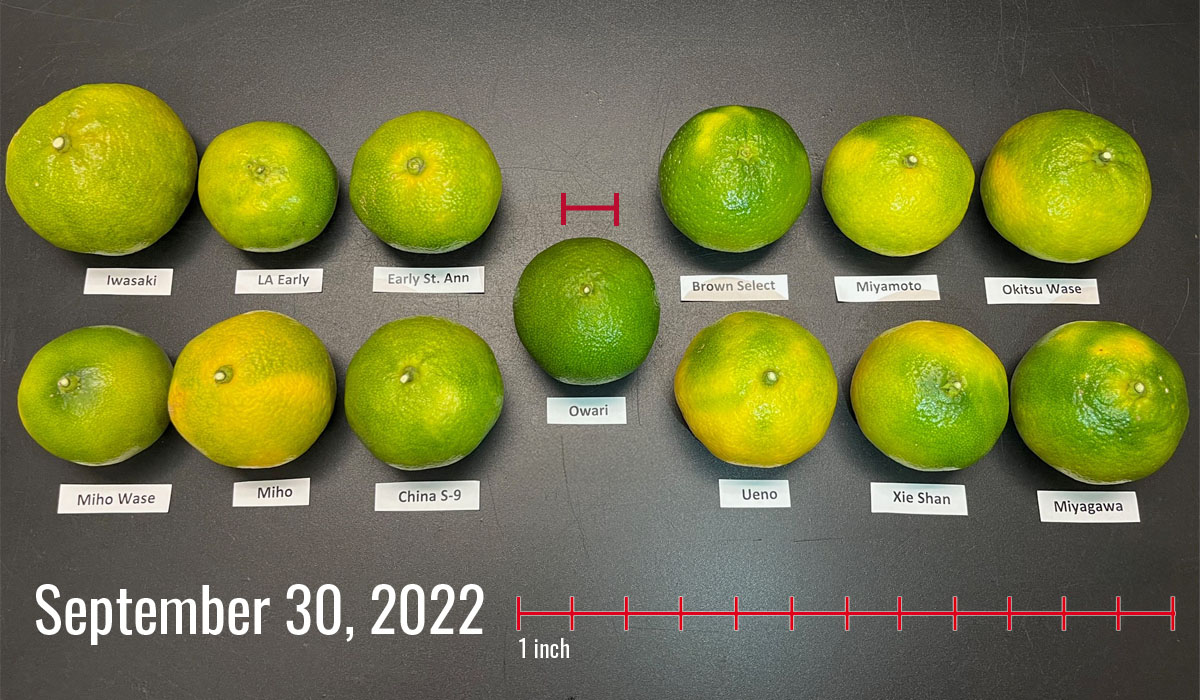
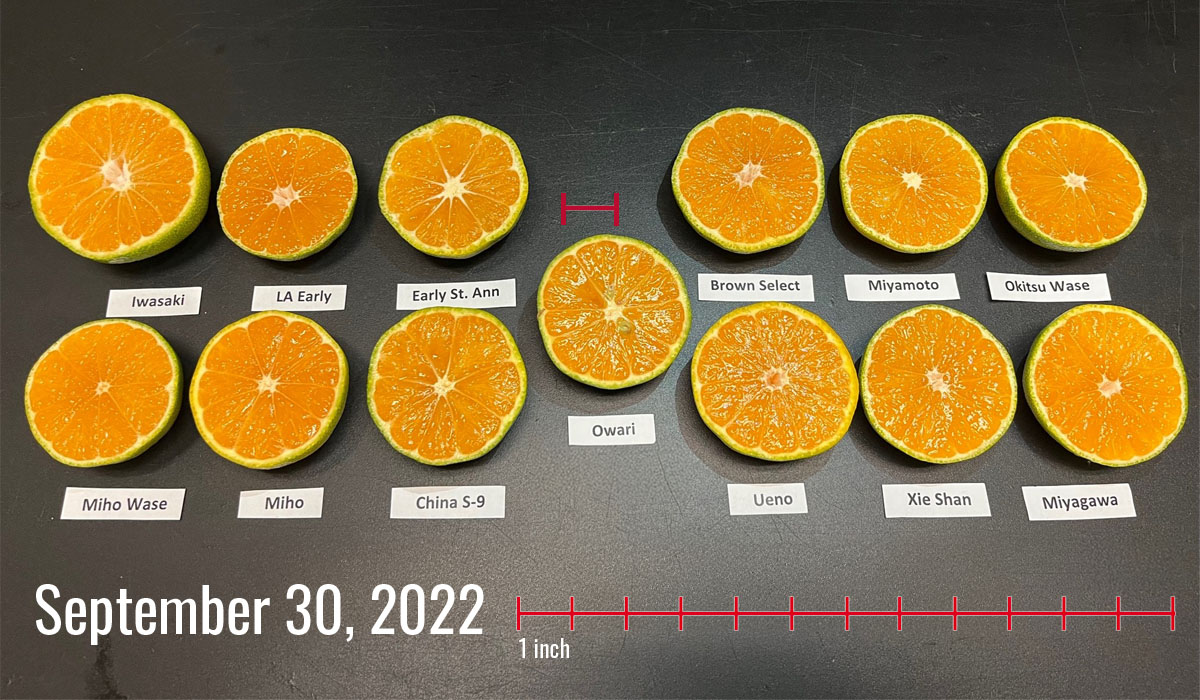
Figure 2. Exterior Fruit Color on September 30, 2022, Compared to ‘Owari’ (center).
Figure 3. Interior Fruit Color on September 30, 2022.
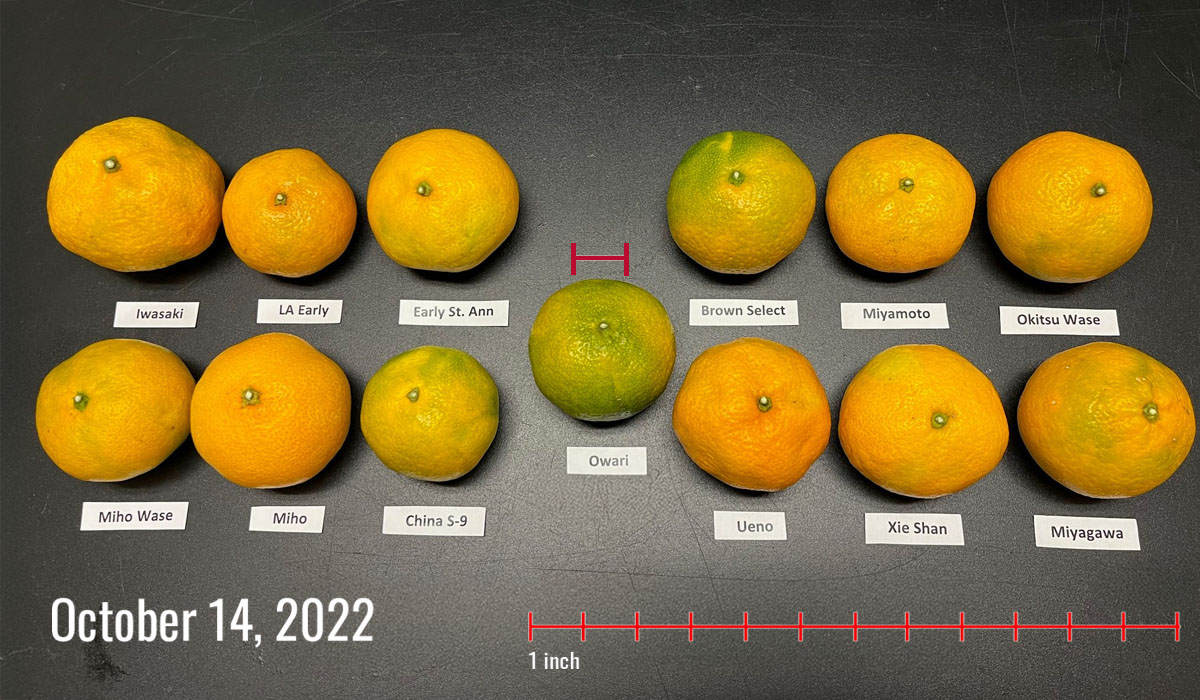
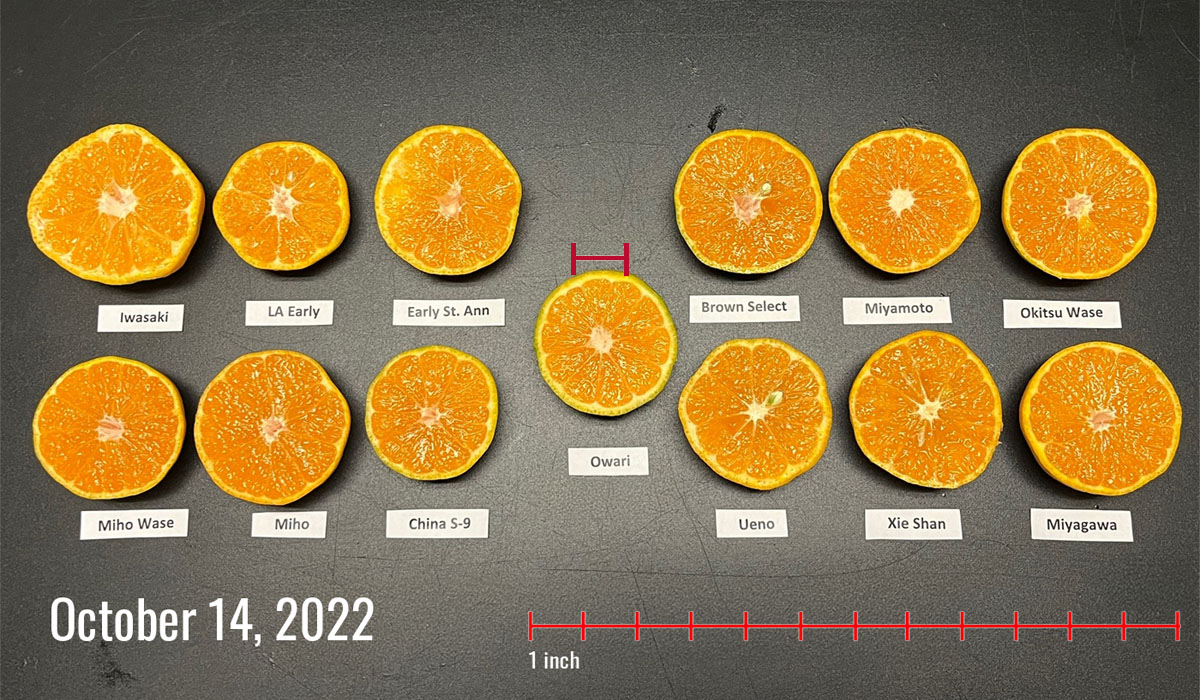
Figure 4. Exterior Fruit Color on October 14, 2022, Compared to ‘Owari’, Showing Good Color Progression.
Figure 5. Interior Fruit Color on October 12, 2022.

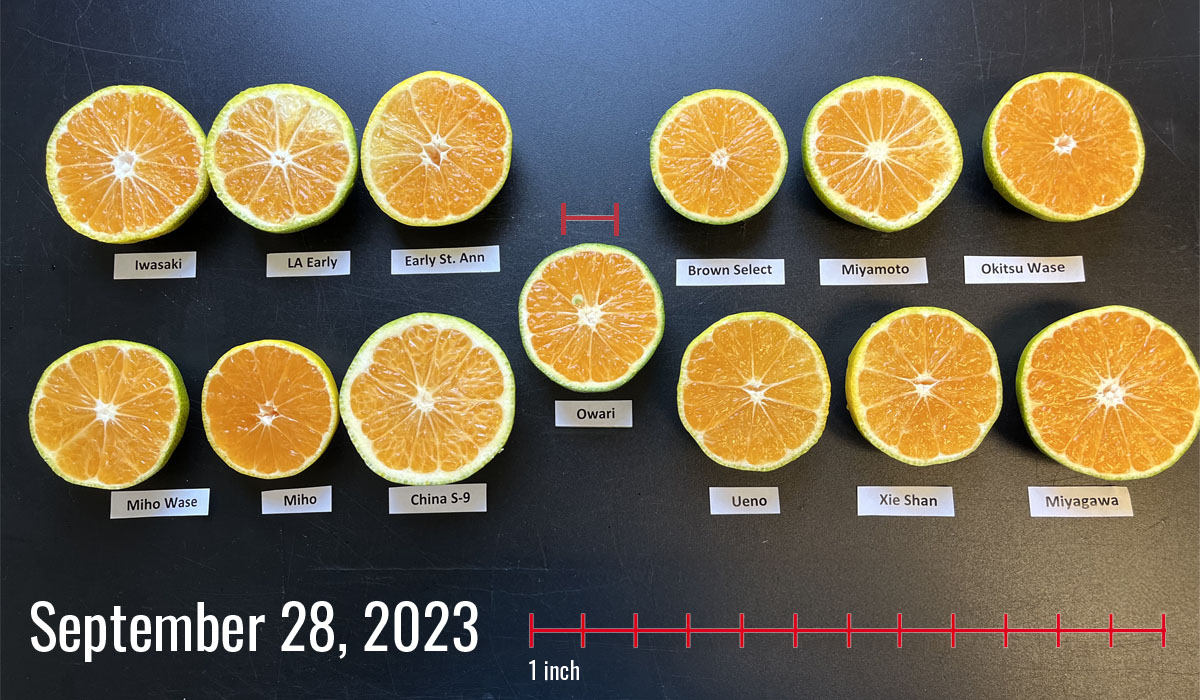
Figure 6. Exterior Fruit Color on September 28, 2023, Compared to ‘Owari’.
Figure 7. Interior Fruit Color on September 28, 2023.
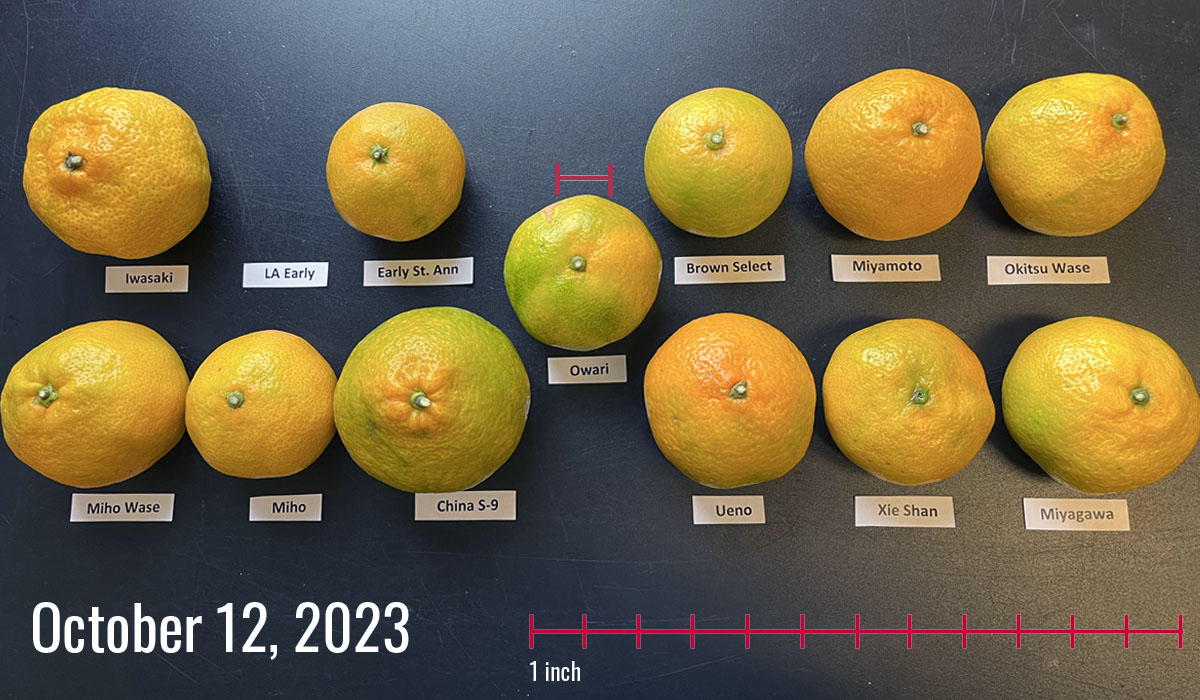
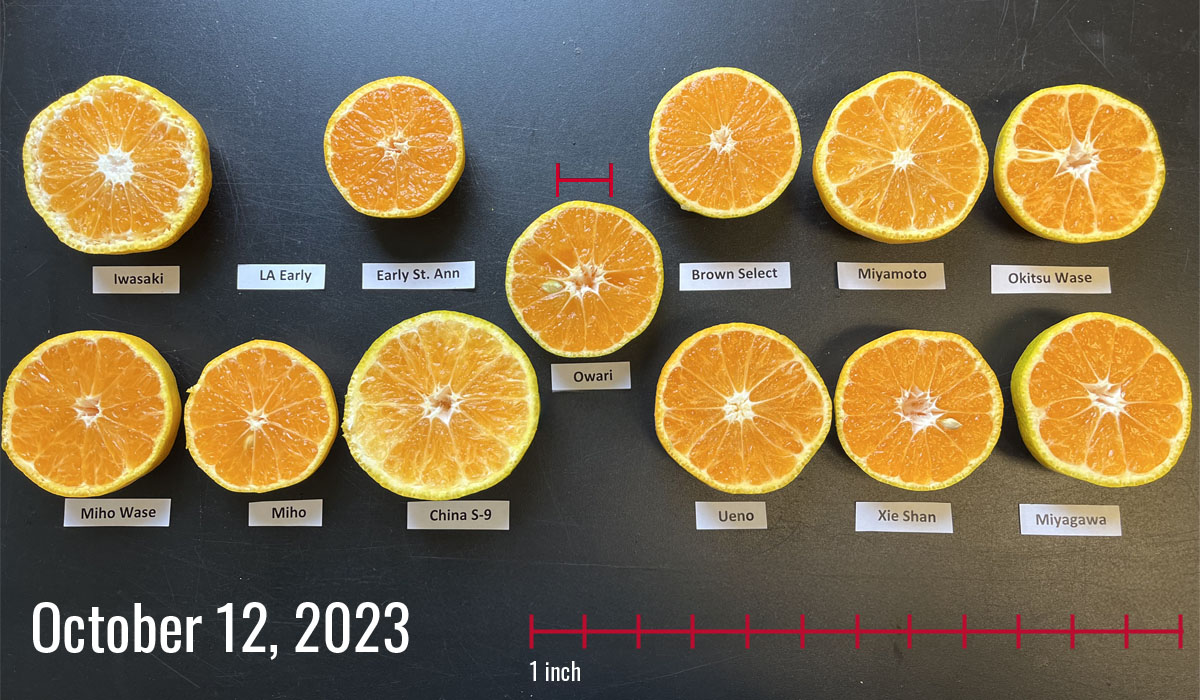
Figure 8. Exterior Fruit Color on October 12, 2023, Compared to ‘Owari’, Showing Good Color Progression.
Figure 9. Interior Fruit Color on October 12, 2023.


